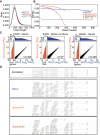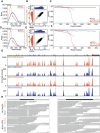Sequencing Illumina libraries at high accuracy on the ONT MinION using R2C2
- PMID: 36351772
- PMCID: PMC9808628
- DOI: 10.1101/gr.277031.122
Sequencing Illumina libraries at high accuracy on the ONT MinION using R2C2
Abstract
High-throughput short-read sequencing has taken on a central role in research and diagnostics. Hundreds of different assays take advantage of Illumina short-read sequencers, the predominant short-read sequencing technology available today. Although other short-read sequencing technologies exist, the ubiquity of Illumina sequencers in sequencing core facilities and the high capital costs of these technologies have limited their adoption. Among a new generation of sequencing technologies, Oxford Nanopore Technologies (ONT) holds a unique position because the ONT MinION, an error-prone long-read sequencer, is associated with little to no capital cost. Here we show that we can make short-read Illumina libraries compatible with the ONT MinION by using the rolling circle to concatemeric consensus (R2C2) method to circularize and amplify the short library molecules. This results in longer DNA molecules containing tandem repeats of the original short library molecules. This longer DNA is ideally suited for the ONT MinION, and after sequencing, the tandem repeats in the resulting raw reads can be converted into high-accuracy consensus reads with similar error rates to that of the Illumina MiSeq. We highlight this capability by producing and benchmarking RNA-seq, ChIP-seq, and regular and target-enriched Tn5 libraries. We also explore the use of this approach for rapid evaluation of sequencing library metrics by implementing a real-time analysis workflow.
© 2022 Zee et al.; Published by Cold Spring Harbor Laboratory Press.
Figures






Similar articles
-
Improving nanopore read accuracy with the R2C2 method enables the sequencing of highly multiplexed full-length single-cell cDNA.Proc Natl Acad Sci U S A. 2018 Sep 25;115(39):9726-9731. doi: 10.1073/pnas.1806447115. Epub 2018 Sep 10. Proc Natl Acad Sci U S A. 2018. PMID: 30201725 Free PMC article.
-
ECNano: A cost-effective workflow for target enrichment sequencing and accurate variant calling on 4800 clinically significant genes using a single MinION flowcell.BMC Med Genomics. 2022 Mar 4;15(1):43. doi: 10.1186/s12920-022-01190-3. BMC Med Genomics. 2022. PMID: 35246132 Free PMC article.
-
Evaluation of strategies for the assembly of diverse bacterial genomes using MinION long-read sequencing.BMC Genomics. 2019 Jan 9;20(1):23. doi: 10.1186/s12864-018-5381-7. BMC Genomics. 2019. PMID: 30626323 Free PMC article.
-
Oxford Nanopore MinION Sequencing and Genome Assembly.Genomics Proteomics Bioinformatics. 2016 Oct;14(5):265-279. doi: 10.1016/j.gpb.2016.05.004. Epub 2016 Sep 17. Genomics Proteomics Bioinformatics. 2016. PMID: 27646134 Free PMC article. Review.
-
Long-read sequencing in deciphering human genetics to a greater depth.Hum Genet. 2019 Dec;138(11-12):1201-1215. doi: 10.1007/s00439-019-02064-y. Epub 2019 Sep 19. Hum Genet. 2019. PMID: 31538236 Review.
Cited by
-
AAVolve: Concatenated long-read deep sequencing enables whole capsid tracking during shuffled AAV library selection.Mol Ther Methods Clin Dev. 2024 Oct 4;32(4):101351. doi: 10.1016/j.omtm.2024.101351. eCollection 2024 Dec 12. Mol Ther Methods Clin Dev. 2024. PMID: 39498467 Free PMC article.
-
Experimental and Computational Methods for Allelic Imbalance Analysis from Single-Nucleus RNA-seq Data.bioRxiv [Preprint]. 2025 Jan 15:2024.08.13.607784. doi: 10.1101/2024.08.13.607784. bioRxiv. 2025. PMID: 39185246 Free PMC article. Preprint.
-
R2C2 + UMI: Combining concatemeric and unique molecular identifier-based consensus sequencing enables ultra-accurate sequencing of amplicons on Oxford Nanopore Technologies sequencers.PNAS Nexus. 2024 Aug 21;3(9):pgae336. doi: 10.1093/pnasnexus/pgae336. eCollection 2024 Sep. PNAS Nexus. 2024. PMID: 39238604 Free PMC article.
-
Circulating cell-free DNA-based methylation pattern in plasma for early diagnosis of esophagus cancer.PeerJ. 2024 Jan 31;12:e16802. doi: 10.7717/peerj.16802. eCollection 2024. PeerJ. 2024. PMID: 38313016 Free PMC article. Review.
-
Estimating error rates for single molecule protein sequencing experiments.PLoS Comput Biol. 2024 Jul 5;20(7):e1012258. doi: 10.1371/journal.pcbi.1012258. eCollection 2024 Jul. PLoS Comput Biol. 2024. PMID: 38968291 Free PMC article.
References
-
- Ali SM, Hensing T, Schrock AB, Allen J, Sanford E, Gowen K, Kulkarni A, He J, Suh JH, Lipson D, et al. 2016. Comprehensive genomic profiling identifies a subset of crizotinib-responsive ALK-rearranged non-small cell lung cancer not detected by fluorescence in situ hybridization. Oncologist 21: 762–770. 10.1634/theoncologist.2015-0497 - DOI - PMC - PubMed
Publication types
MeSH terms
Grants and funding
LinkOut - more resources
Full Text Sources
Other Literature Sources
